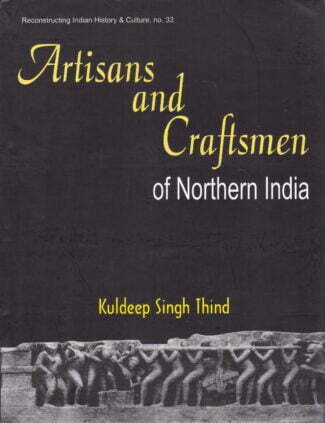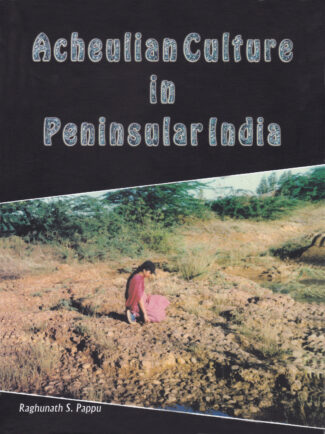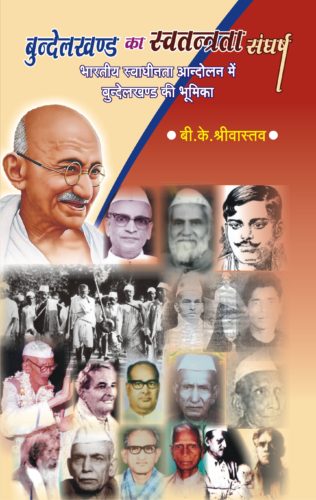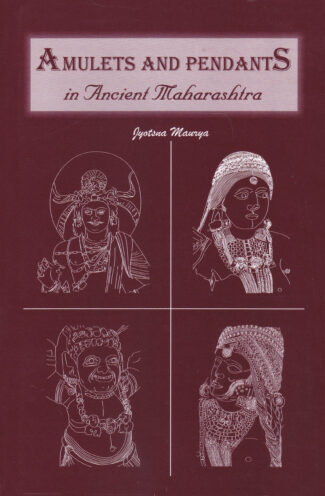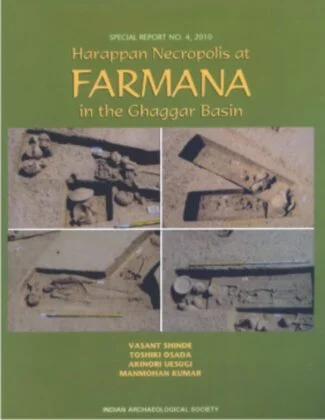

Harappan Necropolis ...
Harappan Necropolis at Farmana in the Ghaggar Basin
by: Vasant Shinde , Toshiki Osada , Akinori Uesugi , Manmohan KumarThis book unfolds the unknown aspects of the Harappan civilization. It throws light on Harappan people’s composition, movement, dietrary habits and burials; and also on the study of human skeletal remains.
$40.00
ISBN: 9788124608494
Year Of Publication: 2009
Edition: 1st
Pages : 103
Language : English
Binding : Paperback
Publisher: Indian Archaeological Society
Size: 28 cm.
Weight: 450
This book unfolds the unknown aspects of the Harappan civilization. It throws light on Harappan people’s composition, movement, dietrary habits and burials; and also on the study of human skeletal remains.
- Archaeology of Mayurbhanj by: Prabodh Kumar Mishra $20.00
Mayurbhanj, the leading princely state of Orissa in the pre-independence days, heroically encountered the twists and turns of history under the peacock-emblemed Bhanjas and continued to flourish for many centuries as an independent sub-regional kingdom, enriching Orissan history and culture in the tribal-dominated region. Today, the splendour of ancient Mayurbhanj (Khijjinga mandala) can be sought in its archaeological treasures that is, fascinating Stone Age tools, copper plate inscriptions, Roman, Kushana and Gupta coins, and spectacular monuments with intricate sculptural work. Professor P.K. Mishra, in this book, attempts to delve into the rich antiquity of Mayurbhanj as evident in its archaeological discoveries that have had a great impact on Orissan culture. The author discusses how under the patronage of enlightened rulers like Maharaja Sriramachandra Bhanj Deo and Purna Candra Bhanj Deo, committed archaeologist-scholars like Kamakshya Prasad Bose, R.P. Chanda, Sailendra Prasad Bose undertook pioneering and painstaking efforts to lay bare Mayurbhanjs ancient wealth. He unfurls the story of Mayurbhanjs discovery in a vivid and interesting account while, at the same time, providing new light on the archaeological excavation and conservation. This work, explaining the rich, intricate past of an area of historical importance, is bound to inspire as well as provide useful information to scholars and researchers involved in Indian history. A very lucid language with constant flow and about 50 photographic representations enhance the value of the book.
- Artisans and Craftsmen of Northern India by: Kuldeep Singh Thind $40.00
The basic aim of the book is to expose the major contributions of artisans and craftsmen in portraying the society in different perspectives. These artisans and craftsmen, were drawn mostly from the shudras, lower caste of the community, suppressed and have-nots section of the society, but were highly talented. The work is also designed to create interest among the reader and scholars alike, to understand the society of the period under reference through the immortal art of these creative people. The artisans such as potters, weavers, carpenters, architects, sculptors, brick-makers, metallurgy and metal workers, leather workers, painters, and the workers engaged in the profession of ivory, glass and mirror, perfume and cosmetic, musical instrument, oil, salt and liquor makers, etc. were the heroes of that time, who not only met the day-to-day requirement of the then society, but also portrayed different aspects of their life, in its true color, through their workmanship. It was the architect who designed and constructed houses to live in, as well as water tank, well and channel, royal building, stupa, temple and fort, bridge, pillar and rock-edict etc., which met the need of the society.
Today, we feel proud of the rich heritage of old Indian art and architecture, credit for which solely goes to the then artisan who crafted immortal creations. However, the invaluable contribution made by the historians in immortalizing their creations, by putting them in black and white, is no less important. It is the historian, whose mighty pen has immortalized not only Ashoka the great, as a king but also the creators of the stupas of his times on equal footings. It is with this aim in view that the present book has been presented to the posterity, in order to pay rich tributes to the creators of our rich cultural heritage.
Unluckly there was no proper institutionalized provision for the education of artisans and craftsmen, so generally the former adopted the occupation of their parents and hereditary skill was enhances as it was transferred from father to son, and generation to generation. Contemporary sources reveal that the social stautus of artisan class was based on the nature and economic conditions of a particular profession. - Acheulian Culture in Peninsular India by: Raghunath S. Pappu $20.00
The Indian sub-continent, particularly the Peninsular India, is recognised as one of the richest areas of Acheulian occupation in the Old World. This research work is a detailed study of the Acheulian Culture system in India signifying the earliest cultural occupation here. The book examines the cultural material of the Acheulian phase in its ecological setting to throw light on the distribution pattern, nature of habitats, Quaternary deposits, mammalian and hominid remains, land use and subsistence, site formation process, genesis and chronology of the Acheulian cultural system. Incorporating his own field observations over the last three decades and more as well as integrating and synthesising the available data and evidence on Acheulian culture, Dr. R.S. Pappu presents a comprehensive understanding of the Acheulian system and, in general, behavioural patterns of early hunting and food gathering communities. He also provides an account of the progress of Palaeolithic research in India since the first discovery of Palaeolithic settlement by Foote in 1863, tracing the major projects and contributions of noted Indian geo-archaeologists.
- Bundelkhand ka Svatantrata Sangarsha by: Brajesh Kumar Shrivastava $28.00
प्रस्तुत पुस्तक के द्वारा भारत के स्वतंत्रता संघर्ष में बुन्देलखण्ड की जनता के योगदान को सामने लाने का प्रयास किसा गया है। गांधीजी की बुन्देलखण्ड यात्रा एवं ओरछा के समीप सतार नदी के किनारे चन्द्रशेखर आजाद के हरिशंकर ब्रह्मचारी के नाम से कुटिया बनाकर रहने से समस्त बुन्देलखण्ड में तेजी से राष्ट्रवादी भावनाओं का प्रसार हुआ। 1923 के झण्डा सत्याग्रह एवं 1930 के जंगल सत्याग्रह में बुन्देलखण्ड के लोगों ने बढ़-चढ़कर भाग लिया। ब्रिटिश भक्त देशी रियासत के राजाओं ने जब जनता पर अत्याचार किया तो जनता ने प्रजामण्डल की स्थापना कर उनका विरोध किया। इसी विरोध के फलस्वरूप संक्रांति के मेले के दिन 14 जनवरी 1931 को छतरपुर जिले में जलियाॅवाला बाग की तरह ही चरण-पादुका हत्याकाण्ड घटित हुआ। पं. माखनलाल चतुर्वेदी ने कर्मवीर समाचार पत्र के माध्यम से 1920 में रतौना में खोले जाने वाले कसाई खाने का इतना प्रखर विरोध किया कि सरकार को घबराकर अपनी कसाईखाना खोलने की योजना त्यागनी पड़ी। यह एक ओर बुन्देलखण्ड की धरती पर अंग्रेजों की करारी शिकस्त थी, तो दूसरी ओर पं. माखनलाल चतुर्वेदी की पत्रकारिता की महत्वपूर्ण जीत थी।
सागर के भाई अब्दुलगनी, ज्वाला प्रसाद ज्योतिषी, केशवराव खाण्डेकर एवं मास्टर बलदेव प्रसाद, दमोह के भैयालाल चैधरी, अजयगढ़ पन्ना के चंदीदीन चैरहा, छतरपुर के पं. रामसहाय तिवारी, टीकमगढ़ के लालाराम वाजपेयी एवं झांसी के भगवानदास माहौर आदि ने बुन्देलखण्ड के स्वतंत्रता संघर्ष को गति, दिशा एवं अर्थ प्रदान किया। इन्हें पं. द्वारका प्रसाद मिश्र एवं पं. सुन्दरलाल तपस्वी का कुशल नेतृत्व एवं मार्गदर्शन मिला। गोवा मुक्ति आन्दोलन में भी सागर की सहोद्राराय एवं केसरी चन्द मेहता सहित अनेक सत्याग्रहियों ने गोवा जाकर आन्दोलन को सफल बनाया। उक्त सभी घटनाक्रम की रोचक, सहज, सरल, सुबोध एवं तथ्यपरक जानकारी इस पुस्तक में दी गई है। छात्रों, शोधार्थियों, शिक्षक बन्धुओं सहित प्रत्येक वर्ग के लोगों को यह पुस्तक ज्ञानवर्धक एवं रुचिकर लगेगी। - Amulets and Pendants in Ancient Maharashtra (3rd c. bc to 3rd c. ce) by: Jyotsna Maurya $20.00
The book documents Indias rich tradition of ornamentation as reflected in its numerous and varied collection of amulets and pendants recovered from archaeological excavations in Maharashtra. It studies the significance of these ornaments as a visible expression of the artistic excellence and cultural wealth of the ancient Indian civilisation particularly at the time of the great Mauryan and Satvahana dynasties. Discussing the evolution of these portable charms against their socio-economic and religious background, the authoress examines the different types of amulets and pendants excavated, the techniques used in making them, their parallels in literary and sculptural representations, and Buddhist influence on them. Giving insights into the sources of raw materials used in these charms, she takes up in detail the trade relations of a specific site with other contemporary sites. With a number of figures and maps, the work promises to be useful to both scholars and students of Indology focussing on facets of Indian culture.




